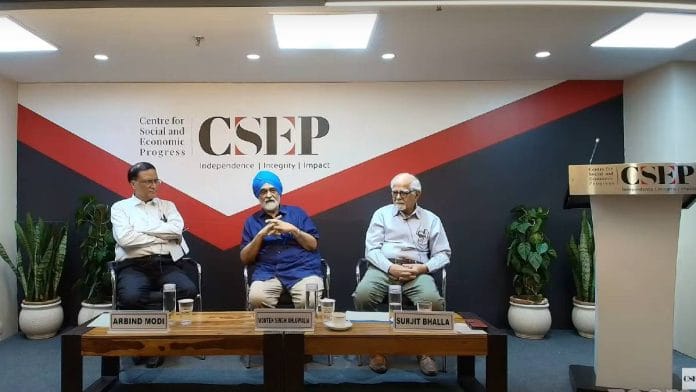New Delhi: India’s tax-to-GDP ratio is notably high compared to other developing Asian countries, according to Surjit Bhalla, former member of the Prime Minister’s Economic Advisory Council (PM-EAC) and former executive director for India at the International Monetary Fund.
Speaking Thursday at a seminar titled ‘Is India’s Tax-to-GDP Ratio Too High or Too Low?’, organised by Delhi-based think-tank Centre for Social and Economic Progress (CSEP), Bhalla also said that the commonly cited figure of 1-2 percent of India’s population paying taxes was inaccurate. He asserted that 20 percent of India’s working population paid taxes.
The tax-to-GDP ratio measures the total tax amount earned by a government against its annual gross domestic product. For India, the ratio currently hovers around 11 percent.
Arbind Modi, a distinguished tax policy expert and former member of the Central Board of Direct Taxes (CBDT), had a different view, however.
Modi argued at the seminar that India’s tax-to-GDP ratio fell significantly short when measured against its potential of 20-25 percent of GDP.
He further pointed out that although many working-class Indians filed income tax returns, a substantial portion did not actually pay taxes.
“India has only 80 million filers, of which 5 million are non-taxpayers who file (returns) only because the law requires them to. It’s not a myth that the tax base is too low in India, it’s a fact,” Modi stated.
While the government provides regular data on the number of tax return filers, it does not do so for the number of taxpayers.
The latest data on the number of taxpayers — for 2022-23 — shows that just 2.24 crore Indians (about 1.6 per cent of the total population) paid income tax that fiscal.
Also Read: Indian taxpayers are ‘dragged’ into paying higher income tax. Govt must factor in inflation
‘Myths’ surrounding India’s taxation system
At the seminar, Modi and Bhalla debated extensively on India’s taxation system and whether recent reforms have bolstered the nation’s growth.
In his presentation, Bhalla addressed four “myths” surrounding India’s taxation system — that India’s tax base is too narrow, tax cuts do not work, India’s tax-to-GDP ratio is low, and investment-to-GDP is low, especially compared to 2004-11.
Talking about the second myth, he argued that tax cuts are effective for increasing tax collections and promoting economic growth, citing the example of corporate tax reductions.
India reduced corporate taxes from 30 percent to 22 percent in 2019, one of the largest reductions globally. Bhalla explained that the COVID-19 pandemic, which began in 2020, delayed the immediate impact of these cuts.
According to Bhalla, corporate tax revenue, adjusted for dividends, increased significantly, rising from 2.52 percent of GDP in 2020 to 3.12 percent of GDP in 2023, following the tax cuts.
Modi contended that the tax cuts failed to achieve their intended outcomes. He argued that India’s corporate tax revenue should have reached 4 percent of GDP but only increased to approximately 3.1 percent.
He advocated for further reductions, noting that the global average corporate tax rate is around 20 percent, whereas India’s rate remains at 25 percent.
“From 30 percent, we have only reduced to 25 percent. Dividends are fully taxed, so the cumulative rate is around 44-45 percent. With such high rates, the Internal Rate of Return for investors is unworkable,” Modi stated.
The Internal Rate of Return or IRR is a metric to calculate the profitability of potential investments.
Modi also advocated for taxing agricultural income above a certain threshold.
Commenting on India’s tax-to-GDP ratio, Bhalla noted that despite being a developing country, India’s tax revenue stands at 19 percent of GDP, which is relatively high.
He highlighted that middle-income and rapidly growing economies typically have much lower tax-to-GDP ratios. “Tax collections are very high in India. We tax too much,” Bhalla said.
(Edited by Nida Fatima Siddiqui)
Also Read: Tax India’s corporates and super-rich more. They can and will take it







For once, agree 100% with Dr Surjit Bhalla.